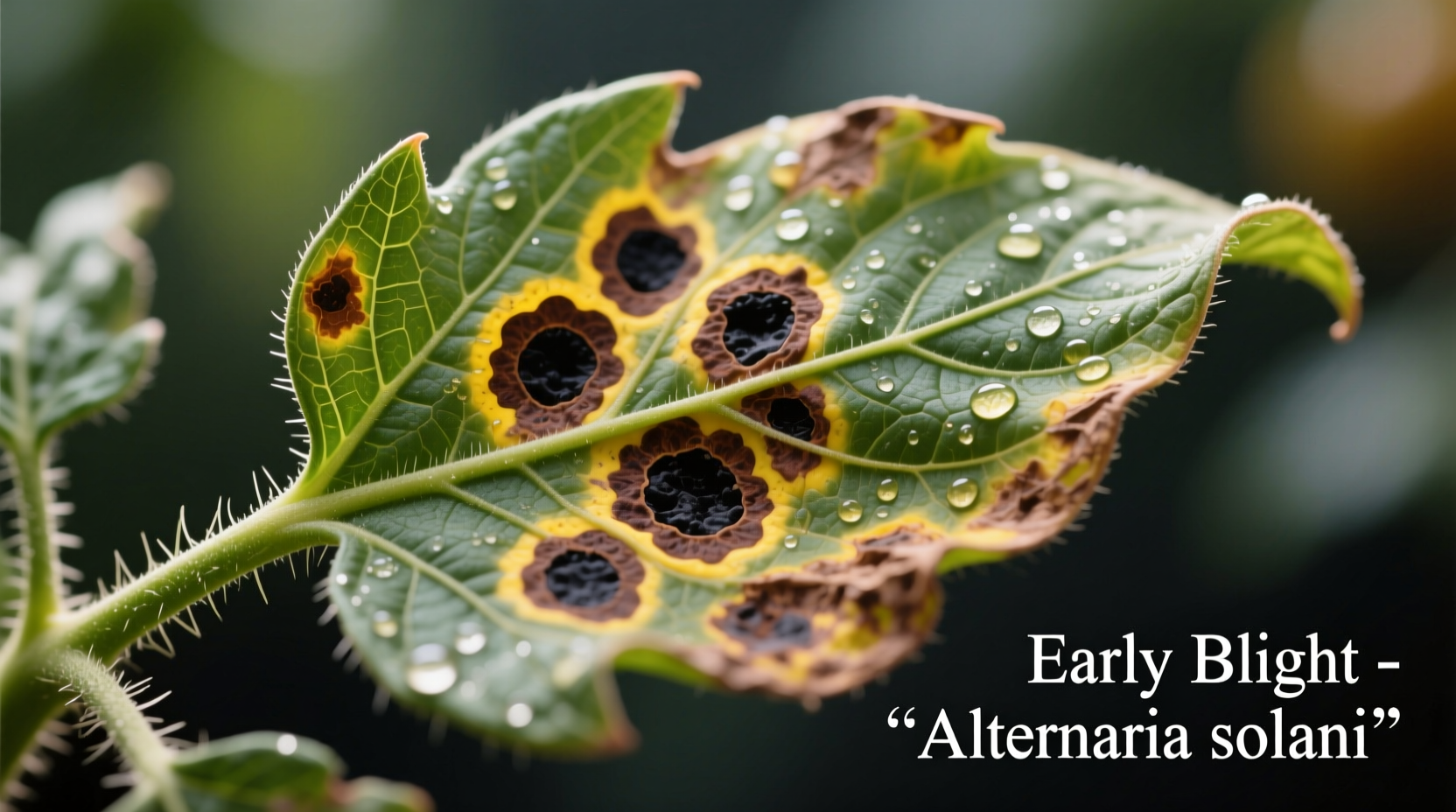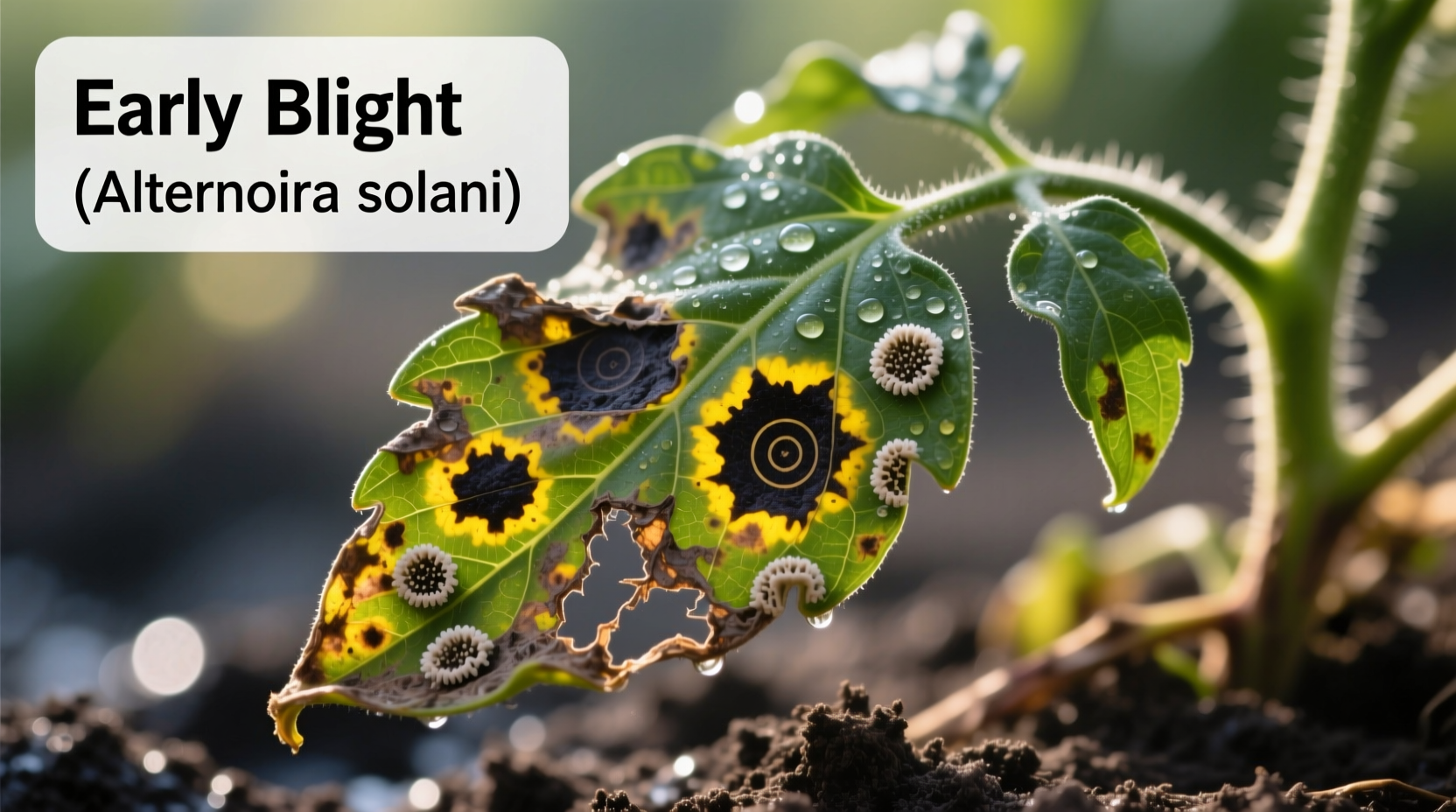Spot Early Blight Before It Devastates Your Tomato Plants
Nothing ruins a gardener's summer faster than watching healthy tomato plants succumb to disease. When you notice those first dark spots with distinctive bullseye patterns appearing on your lower leaves, you're likely facing tomato early blight. This common fungal disease affects tomato crops worldwide, but catching it early and implementing the right strategies can save your harvest.
What You're Seeing Right Now: Early Blight Identification
If your tomato plants show these symptoms, early blight is likely the culprit:
- Small, dark brown spots (⅛ inch) appearing first on older, lower leaves
- Spots expanding with distinctive concentric rings (bullseye appearance)
- Yellow halo developing around each lesion
- Leaves turning yellow, then brown, eventually dying and falling off
- Stem lesions appearing as dark, sunken areas
- Fruit lesions showing as black, leathery rot at the stem attachment point
Don't confuse early blight with other common tomato diseases. Here's how to distinguish between similar conditions:
| Disease | Leaf Symptoms | Stem Symptoms | Fruit Symptoms | Key Differentiator |
|---|---|---|---|---|
| Early Blight | Dark spots with concentric rings, yellow halo | Dark, sunken lesions | Black, leathery rot at stem attachment | Bullseye pattern on spots |
| Late Blight | Water-soaked, irregular spots with white mold | Dark, water-soaked lesions | Large, firm, brown rot | Rapid spread in cool, wet weather |
| Septoria Leaf Spot | Small, circular spots with dark border and light center | Rarely affects stems | Does not affect fruit | Many small spots per leaf |
Why Early Blight Targets Your Tomatoes: The Science Explained
Early blight (Alternaria solani) thrives under specific conditions that make your garden vulnerable. Understanding these factors helps prevent future outbreaks:
The fungus survives in soil on infected plant debris and can remain viable for over a year. According to research from the University of Minnesota Extension, spores spread primarily through water splash from rain or irrigation, with infection occurring when leaves remain wet for 8-12 hours at temperatures between 75-85°F (24-29°C).
Here's the disease progression timeline you're likely experiencing:
- Day 1-3: Initial infection occurs when spores land on wet leaves
- Day 4-7: First small, dark spots appear on lower leaves
- Day 8-14: Spots enlarge with concentric rings, yellow halos develop
- Day 15-21: Infected leaves yellow completely and drop off
- Day 22-30: Disease moves up plant, potentially reaching fruit
Immediate Action Plan: What to Do Today
If you've identified early blight, take these critical steps immediately to save your crop:
- Remove infected leaves - Carefully prune affected lower leaves (wear gloves and sanitize tools between cuts)
- Improve air circulation - Space plants properly and stake tomatoes to keep foliage off the ground
- Adjust watering practices - Water at soil level early in the day to prevent prolonged leaf wetness
- Apply protective mulch - Use straw or black plastic mulch to prevent soil splash
- Begin treatment - Start appropriate fungicide applications immediately

Effective Treatment Options for Existing Infections
When early blight has already taken hold, targeted treatments can stop its progression. The effectiveness depends on how early you intervene:
Organic solutions that work:
- Copper-based fungicides - Apply every 7-10 days during wet periods (follow label instructions)
- Chlorothalonil - Effective protectant fungicide available to home gardeners
- Baking soda spray (1 tbsp baking soda, 1 tsp horticultural oil, 1 gallon water) - Helps raise leaf pH to inhibit fungal growth
- Neem oil - Provides some suppression when applied regularly
According to Oregon State University Extension, fungicide applications are most effective when started at the first sign of disease and continued on a regular schedule throughout the growing season, especially during wet weather.
Important context boundaries: Treatments work best when combined with cultural practices. Fungicides alone won't save plants if you continue overhead watering or ignore sanitation. Once more than 50% of foliage is affected, recovery becomes significantly more difficult.
Preventing Future Outbreaks: Your Long-Term Strategy
Prevention is always better than treatment when managing early blight. Implement these practices to protect future crops:
- Practice crop rotation - Avoid planting tomatoes or related crops (potatoes, eggplants, peppers) in the same location for 2-3 years
- Select resistant varieties - While no tomatoes are completely resistant, varieties like 'Mountain Magic,' 'Plum Regal,' and 'Defiant PHR' show better tolerance
- Start clean - Use disease-free seeds or transplants and sanitize tools regularly
- Water wisely - Use drip irrigation or soaker hoses to keep foliage dry
- Remove plant debris - Clean up all tomato plant material at season's end
- Strengthen plants - Maintain proper nutrition (avoid excess nitrogen) and healthy soil
When to Accept Losses and Move On
Despite your best efforts, sometimes early blight becomes too severe to manage. Recognize these signs that it's time to remove affected plants:
- More than 70% of foliage has been lost
- Fruit production has significantly decreased
- Disease has spread to multiple plants despite treatment
- Plants show signs of secondary infections
When removing infected plants, bag them immediately to prevent spore spread and dispose of them in the trash (not compost). Thoroughly clean tools and gloves afterward.
Building Resilience: Your Complete Early Blight Management Plan
Managing early blight requires a season-long approach. Here's your comprehensive timeline for success:
- Before planting: Test soil, amend as needed, select resistant varieties, prepare crop rotation plan
- At planting: Space plants properly, install supports, apply mulch, consider preventative fungicide
- Early season: Monitor weekly for symptoms, maintain proper watering, remove lower leaves touching soil
- Mid-season: Continue monitoring, begin fungicide applications if conditions favor disease, remove infected leaves promptly
- Late season: Continue management, harvest ripe fruit promptly, prepare for end-of-season cleanup
- After harvest: Remove all plant debris, sanitize tools, plan next year's rotation
Remember that early blight management isn't about finding a single magic solution—it's about creating an environment where your tomato plants can thrive while making it difficult for the fungus to establish and spread.
FAQ: Tomato Early Blight Questions Answered
Can I eat tomatoes from plants with early blight?
Yes, you can safely eat tomatoes from infected plants as long as the fruit itself shows no lesions. The fungus doesn't produce toxins harmful to humans. Simply cut away any affected areas on the fruit and wash thoroughly before consumption.
How long does early blight survive in soil?
Early blight spores can survive in soil for 1-2 years on infected plant debris. This is why crop rotation with non-solanaceous plants for at least 2-3 years is recommended to reduce inoculum levels in the soil.
Does baking soda really work for early blight?
Baking soda sprays can help prevent early blight by raising the pH of leaf surfaces, making them less hospitable to fungal growth. A solution of 1 tablespoon baking soda, 1 teaspoon horticultural oil, and 1 gallon of water applied weekly can provide some protection, but it's less effective than commercial fungicides for active infections.
Can I compost tomato plants with early blight?
No, do not compost infected tomato plants. Early blight spores can survive typical home composting temperatures. Instead, bag infected plant material and dispose of it in the trash to prevent spreading the disease to next year's garden.











 浙公网安备
33010002000092号
浙公网安备
33010002000092号 浙B2-20120091-4
浙B2-20120091-4